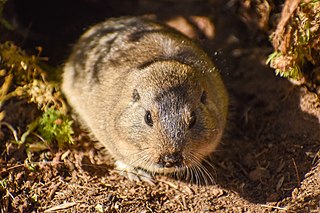
A tuco-tuco is a neotropical rodent in the family Ctenomyidae. Tuco-tucos belong to the only living genus of the family Ctenomyidae, Ctenomys, but they include approximately 60 different species. The common name, "tuco-tuco", comes from the "tuc-tuc" sound they make while they dig their burrows.

Haig's tuco-tuco, known regionally as the Patagonian tuco-tuco, is a hystricognath rodent. Like other tuco-tucos it is subterranean and thus not often observed, although the "tuc-tuc" call of the males can be heard near burrow sites, especially in the early morning. Like most species in the genus Ctenomys, C. haigi are solitary, with one adult per burrow.

The Brazilian tuco-tuco is a tuco-tuco species. It is found mainly in the state of Minas Gerais in southeastern Brazil, though Charles Darwin mentions it during his trip through present-day Uruguay.
The Argentine tuco-tuco is a species of rodent in the family Ctenomyidae. It is endemic to Argentina.

Colburn's tuco-tuco is a species of rodent in the family Ctenomyidae. Its only known habitat is in Argentina.
The Catamarca tuco-tuco is a species of rodent in the family Ctenomyidae. It is endemic to Argentina.
The San Luis tuco-tuco is a species of rodent in the family Ctenomyidae. It is endemic to Argentina.
The Salta tuco-tuco is a species of rodent in the family Ctenomyidae. It is endemic to Argentina and Bolivia.

The silky tuco-tuco is a species of rodent in the family Ctenomyidae. It is endemic to Argentina.

The Tucuman tuco-tuco is a species of rodent in the family Ctenomyidae. It is endemic to Argentina.
The Puntilla tuco-tuco is a species of rodent in the family Ctenomyidae. It is endemic to central Argentina. The common name of the species comes from the municipality of La Puntilla at the type locality. It was first described by the British zoologist Oldfield Thomas in 1920 after being collected by Emilio Budin, an Argentine specimen collector who worked with Oldfield Thomas.
The Coyhaique tuco-tuco is a species of rodent in the family Ctenomyidae. It is endemic to southern Chile. The name comes from the Chilean province and municipality of Coyhaique.
The Famatina tuco-tuco is a species of rodent in the family Ctenomyidae. It is endemic to northern Argentina. The common name of the species comes from the municipality, department and mountain range of the same name at the type locality.

Flamarion's tuco-tuco or the tuco-tuco of the dunes is a rodent species of the family Ctenomyidae Its karyotype has 2n = 48 and FN = 50–78. It is endemic to the coastal dunes of Rio Grande do Sul state, southern Brazil. The species is threatened by habitat loss due to dune removal and urbanization. It is named after Brazilian biologist Luiz Flamarion B. de Oliveira.
The Jujuy tuco-tuco is a species of rodent in the family Ctenomyidae. It is known only from one location at an elevation of 500 m in southeastern Jujuy Province of northern Argentina.
Pundt's tuco-tuco is a species of rodent in the family Ctenomyidae. It is endemic to the Pampas of southern Córdoba and San Luis Provinces in central Argentina. The species is named after Argentine landowner and collector Moritz Pundt. It has a fragmented population and is threatened by conversion of its habitat to agricultural use.
Scaglia's tuco-tuco is a species of rodent in the family Ctenomyidae. It is endemic to a locality in Tucumán Province, northern Argentina. The species is named after Argentine naturalist Galileo Juan Scaglia (1915–1989). Its karyotype has 2n = 36 and FN = 64.
The Sierra Tontal tuco-tuco is a species of rodent in the family Ctenomyidae. It is known only from a small locality in the Sierra del Tontal, San Juan Province, west central Argentina.

Yolanda's tuco-tuco is a species of rodent in the family Ctenomyidae. The species is endemic to Santa Fe Province, northeast Argentina, where it lives near the Paraná and San Javier rivers. Its karyotype has 2n = 50 and FN = 78. It is named after Argentine biologist Yolanda Davis.







